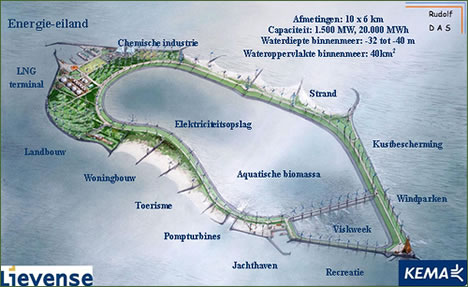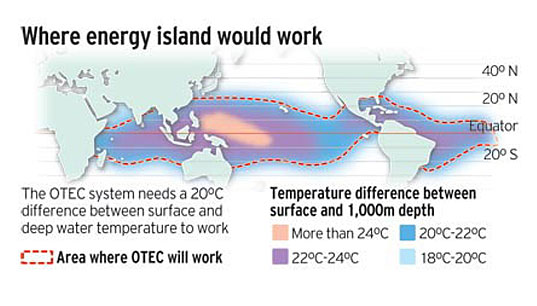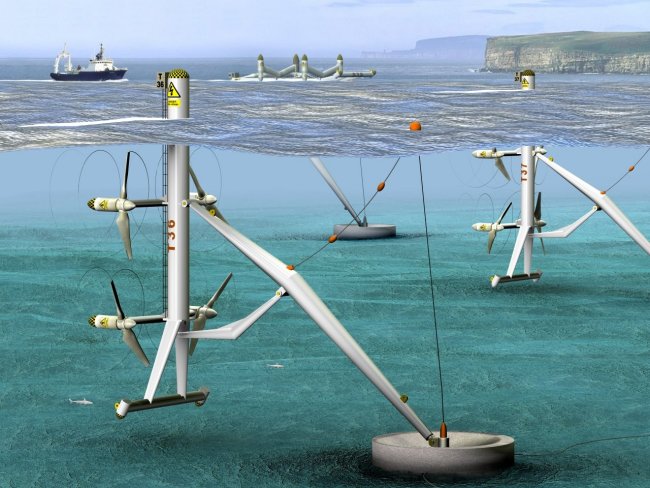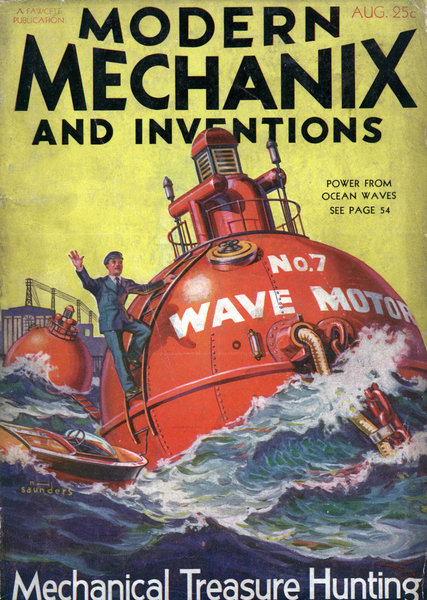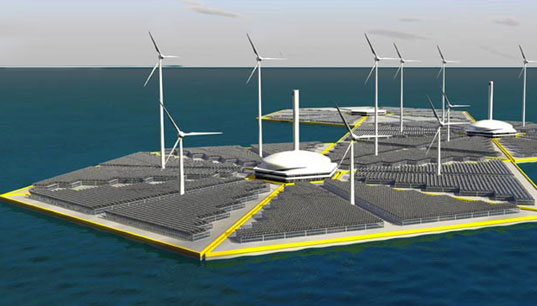Tapping The Source: The Power Of The Oceans
Posted by Big Gav in energy, energy islands, ocean power, otec, power, tidal power, wave power
Last year I came across the story of Dutch company Kema and their energy island idea - basically a variant on the usual pumped hydro energy storage concept where water is pumped out of a space below sea level then allowed to flow back in, generating power as it does. The "island" uses wind power to pump water out of the enclosed area. An obvious extension to this idea would be to harness ocean energy as well - letting wave and/or tidal power supplement the output of the wind turbines. An attraction of this concept is that it potentially allows a large amount of new energy storage to be brought online - and this storage would be along the world's coastlines, where most of the population lives.
Another form of energy island has been in the news recently, this one a substantially more ambitious proposal which envisions artificial islands to collect wind, wave, ocean current and solar power in the tropics, along with a more unusual energy source - harnessing the difference in water temperatures between the warm surface and the cold depths using a technique called OTEC (Ocean Thermal Energy Conversion). These islands are being proposed by architects Dominic Michaelis and his son Alex Michaelin as a response to Richard Branson’s Virgin Earth Challenge, which offers $25 million in prizes for innovative solutions for combating global warming.
While the practicality of these particular proposals has yet to be put to the test, the various forms of ocean power are probably the most overlooked of the big 6 renewable energy sources (along with solar, wind, geothermal, biomass and hydro).
Other forms of renewable energy are sometimes criticised for being more intermittent and less predictable than traditional power generation, however ocean energy is much more reliable - steady ocean currents could provide good baseload power, as could OTEC, tidal power is diurnal and highly predictable and waves are predictable days in advance.
In this post I'll have a look at the amount of energy that could potentially be harvested from these sources and the various projects underway to try and make this a reality.
Tidal and Ocean Current Power
Tidal power stations usually take the form of a dam (or barrage) built across a narrow bay or river mouth. As the tide flows in or out, it creates uneven water levels on either side of the barrier. The water flows through the barrier, turning turbines to generate electricity.
Benefits of tidal barrage power generation include :
* Predictable source of clean energy
* No dependence on foreign fuel sources
* Flood protection
* Transport links for road and/or rail
* Better shipping and boating conditions behind the barrier
Disadvantages include :
* The timing of the tides doesn't often correlate with peak demand times (less of a problem if there are good energy storage options available)
* Existing ecosystems behind the barrage tend to be heavily altered
* Likely to stimulate silting in some areas and coastal erosion in others
* Enhance flood risk on the seaward side
* Shipping would have to navigate locks
* Industrial discharges behind the barrage are less likely to be dispersed out to sea
Variations on this theme include offshore tidal lagoons, which use a water impoundment structure and low-head hydroelectric generating equipment on shallow tidal flats, and tidal fences, which are composed of a number of individual vertical axis turbines mounted within the fence structure, known as a caisson.
Underwater turbines can also be used to harness both tidal power and ocean current power. The turbines (sometimes called aquanators) are similar to wind turbines. In water moving between 6 and 9 km per hour, a 15 m diameter water turbine could generate as much energy as a 60 m diameter wind turbine. Given the smaller amount of infrastructure required and the larger range of possible sites that this technology could be deployed to, it seems likely that underwater turbines will become much more widespread than tidal barrage style generation.
World tidal energy resources have been estimated at around 3000 GW, however less than 3% of this is located in areas considered suitable for power generation (these figures probably don't include ocean current power, which doesn't seem to be well studied).
A 240 MW tidal-barrage power plant has been operating at La Rance in Brittany since 1966. Other operational barrage sites are at Annapolis Royal in Nova Scotia (18 MW), the Bay of Kislaya near Murmansk and at Jangxia Creek in the East China Sea.
 The largest tides in the world are found in Canada's Bay of Fundy, which has been earmarked to become a 4-berth test site for tidal power generation next year.
The largest tides in the world are found in Canada's Bay of Fundy, which has been earmarked to become a 4-berth test site for tidal power generation next year. On the west coast of Canada, Marine Current Turbine and BC Tidal Energy Corporation plan to install at least three 1.2 MW tidal energy turbines in Vancouver Island's Campbell River by 2009. This the first step in a plan to develop larger tidal farms off British Columbia's coast, which the company says have a tidal energy potential of up to 4,000 MW.
In the United States, at the southern end of the Bay of Fundy, lies Passamaquoddy Bay, which has long been a target for a tidal power development - first initiated in 1935 by the Public Works Administration under the Roosevelt administration, then halted by Congress a year later. John F Kennedy revived the 550 MW project in 1963, however the plan died with him (spawning one of the stranger JFK assassination conspiracy theories I have come across).
Further south, in the Martha's Vineyard area, two underwater turbine projects are trying to get started - one a 300 MW proposal from Oceana Energy Company and the other from Natural Currents Energy Services. Other projects are being considered in the Cape Cod and New Bedford areas - part of a "gold rush" for good tidal power sites (the most desirable ones usually have hourglass figures, to get maximum force in the incoming tide) which has seen the FERC issue 47 preliminary permits for ocean energy projects (and generated mainstream news coverage on the NBC network).
New York's East River is the location of one of the more high profile tidal power experiments currently underway, with Verdant Power experimenting with underwater turbines there. The first attempt eventually ended in failure, with the strong tides breaking the devices.
The Gulf Stream has also caught the eye of hopeful ocean energy companies, particularly in Florida, with the 30 mile wide current pushing 8.5 billion gallons of water along per second and prompting some observers to consider the prospect of "Infinite Underwater Energy".
Californian utility PG&E is also investigating tapping tidal power in San Francsico Bay, with some observers talking about a plant of up to 400 MW in size.
Another bay famous for its tides is the Severn river estuary in Britain, with a tidal range of 14 metres. Plans for damming the Severn estuary or Bristol channel have existed since the 19th century (with tidal power generation being just one proposed application). The UK government recently proposed a new barrage design, which could produce 5% of the UK's electricity requirements, with a peak rate of 8.6 GW. A feasibility study is expected to be complete by 2010. An alternative proposal, by Tidal Electric, involves a series of lagoons, the first of which would be built in Swansea Bay. Some observers have noted underwater turbines may be more appropriate than a barrage.
 Pentland Firth in Scotland is another UK location that is considered to have a large amount of tidal power potential - a DTI study in 1993 indicated that if all potential sites were developed, the total UK tidal stream resource could be about 60 TWh. Of this, almost half (28 TWh) could come from the Pentland Firth. The water depth is 60m or more, making potential energy capture huge but technically difficult - 63% of the tidal stream resource is estimated to be in waters deeper than 40m.
Pentland Firth in Scotland is another UK location that is considered to have a large amount of tidal power potential - a DTI study in 1993 indicated that if all potential sites were developed, the total UK tidal stream resource could be about 60 TWh. Of this, almost half (28 TWh) could come from the Pentland Firth. The water depth is 60m or more, making potential energy capture huge but technically difficult - 63% of the tidal stream resource is estimated to be in waters deeper than 40m.Marine Current Turbines launched the world's first underwater turbine project off north Devon in 2003. MCT also began installing a 1.2 MW "SeaGen" tidal current turbine in Northern Ireland's Strangford Lough in 2007, with the company planning to scale up to build a 10MW tidal power farm off Anglesey in North Wales, and to have 500MW of tidal capacity by 2015. Also in Wales, Lunar Energy and Eon are hoping to build an underwater tidal project off Pembrokeshire.
Another UK tidal power proposal is part of a plan by Metrotidal to build a tunnel under the Thames, currently under fire from environmental groups. There is also talk about regions like the Isle Of Wight and the Humber estuary harnessing tidal power as part of initiatives to become energy self-sufficient (like other "Transition Towns").
Norway has also begun investigating the use of tidal power, with an experimental facility opening in Hammerfest in 2003. The company that developed that technology, Hammerfest Strøm, is working with Scottish Power to develop a project near the Orkney Islands (the islands have also been a test site for another venture by Lunar Energy and Rotech).
There has been no tidal power development in Australia thus far, though the Kimberly region has long been a target for would be developers of tidal power projects, due to its enormous potential (a tidal range of 11 metres). Thus far all of the proposed projects have been stymied by the remoteness of the location from the Western Australian and national electricity grids and by environmental concerns. A number of possible sites have been identified, including Secure Bay, Walcott Inlet, George Water and St. George's Basin.
Liberal backbencher Wilson "Ironbar" Tuckey has been the most vocal supporter of a Kimberly tidal project, pointing out if a link was built to the eastern states grid it would obviate the need for any consideration of nuclear power. Some Kimberly tidal power advocates have also tried to base the idea of a "hydrogen economy" on the resource, though this seems a lot more far-fetched than a grid link (the grid link could also potentially include large scale CSP solar in the western australian deserts, which are one of the best solar resources in the world) .
The Bass Strait area is also considered to have significant potential for tidal / ocean current power generation (one estimate claiming there is potential for 3000 MW of generation in the channel between King Island and Cape Otway).
New Zealand is another country with large tidal resources but without any existing tidal energy generation. According to TVNZ, there are at least 24 wave and tidal power projects currently under development. Trying to get a handle on who might be behind these projects isn't easy - there is an NZ wave and tidal power association, but it doesn't list members or projects - according to their latest newsletter they have 59 members. Crest Energy seems to be the most prominent local company, with a plan for a 200 MW plant in Kaipara Harbour using underwater turbines. Other potential locations include Manukau and Hokianga Harbours, and Tory Strait and French Pass in the Marlborough Sounds. The harbours produce 5 to 6-knot currents and tidal flows of 100,000 cu m a second from the flood and ebb tides, with tidal volumes 12 times greater than the flow in the largest local rivers.
The Phillipines is another potential location for tidal power, with a 2.2GW tidal fence proposed for the Dalupiri Passage using the Davis turbine, from the Blue Energy company and an estimated cost of $US 2.8 Billion is unfortunately on hold due to political instability.
South Korea also has ambitions to generate power from ocean currents, with pilot underwater turbines being installed at Uldolmok, in the country's south-west. Researchers at the Korea Ocean Research and Development Institute (KORDI) chose the site because it has flows up to 12 knots, believed to be among the fastest in Asia. The strong currents have resulted in a number of accidents, hampering progress. KORDI is also trying to improve the efficiency of more conventional barrage-type tidal power plants. The primary project involves building a power plant with a capacity of 250 MW at Lake Sihwa, with another plant up to 520 MW being considered for Garolim Bay.
Taiwan is another Asian nation considering the the possibility of large-scale ocean current power generation. There have been discussions about using the strong Kuroshio current off the east coast of Taiwan to generate up to 1.68 trillion kilowatt-hours per year (compared to Taiwan's current annual demand of electricity of around 98 billion kilowatt-hours).
Wave Power
Surface waves and pressure variations below the ocean's surface can be used by floating buoys or submerged platforms to generate intermittent power. Wave energy sources are widely available, are relatively consistent and predictable and (According to analysts Frost and Sullivan) have the highest energy density among all renewable energy sources. The best resource is found between 40-60 degrees of latitude where the available resource is 30 to 70 kW/m, with peaks of 100 kW/m. The potential global wave power potential has been estimated to be around 8,000-80,000TWh/y (1-10TW), which is the same order of magnitude as world electrical energy consumption.
The UK, for example, is estimated to possess the capacity to generate approximately 87 TWh of wave power per year - equivalent to almost 25 per cent of current UK demand. There are two main research centres in Europe focusing on the development and commercialisation of ocean energy technologies. The first is the European Marine Energy Centre located in Orkney, Scotland, which provides developers with sites to test their prototypes. The other is the Wave Energy Centre in Portugal.
Wave energy ideas are plentiful but real world examples are still rare - there are around 1000 patents for wave energy converters currently on the market and no consensus has emerged yet on which technologies will succeed.
 Australian company Oceanlinx (previously known as Energetech) has had a 450 kilowatt wave power unit running at Port Kembla in NSW for a number of years, and plans to connect to the commercial power grid in early 2008. Oceanlinx is also at the advanced permitting stage for a project in Portland, Victoria which would deploy eighteen 1.5MW units for a total capacity of 27MW, which the company claims will be the largest wave energy project in the world.
Australian company Oceanlinx (previously known as Energetech) has had a 450 kilowatt wave power unit running at Port Kembla in NSW for a number of years, and plans to connect to the commercial power grid in early 2008. Oceanlinx is also at the advanced permitting stage for a project in Portland, Victoria which would deploy eighteen 1.5MW units for a total capacity of 27MW, which the company claims will be the largest wave energy project in the world. The company has other projects planned in Rhode Island, Hawaii and Namibia, and intends to participate in the South West of England Regional Development Agency's "Cornwall Wave Hub" in the UK.
The Cornwall Wave Hub aims to create the world's first large scale wave energy farm by constructing a wave hub, or "socket", on the seabed. Oceanlinx is participating along with Ocean Power Technologies, Fred Olsen Renewables and WestWave. Ireland is looking to build a similar grid connected test facility on the Mullet Peninsula in Ireland's County Mayo. While the marine renewables industry in the UK seems to be quite vibrant, government programs to fund the sector have been criticised for not spending the money they have been allocated.
 Another Australian company, Carnegie Corp has installed a small array of its CETO II units off Fremantle in WA, and is looking to set up a 50 MW facility in South Australia to desalinate seawater for the Adelaide market and the mining industry. The CETO technology was devised in the 1970s by Carnegie's chairman Alan Burns, a well-known Perth oil man who also founded Hardman Resources. It operates mostly underwater rather than on the surface like many buoy based alternatives, which the company believes will result in a much lower likelihood of damage from storms and rough conditions.
Another Australian company, Carnegie Corp has installed a small array of its CETO II units off Fremantle in WA, and is looking to set up a 50 MW facility in South Australia to desalinate seawater for the Adelaide market and the mining industry. The CETO technology was devised in the 1970s by Carnegie's chairman Alan Burns, a well-known Perth oil man who also founded Hardman Resources. It operates mostly underwater rather than on the surface like many buoy based alternatives, which the company believes will result in a much lower likelihood of damage from storms and rough conditions.Another Australian company exploring wave (and tidal) power is Sydney based BioPowerSystems, which is trying to is commercialise "biomimetic ocean energy conversion technologies" (an example of "biomimicry", which I'll be doing a post on at a later date). BioPower has been awarded a $5 million grant under the Australian Government's AusIndustry Renewable Energy Development Initiative to test prototypes of the wave energy device (most likely at King Island) and the tidal energy device (at Flinders Island), with each generating around 250 kW.
 Pelamis Wave power is a Scottish company that is constructing a 3 MW wave farm off the coast of the Orkney Islands. The company is also involved in the construction of a 2.25 MW plant in Portugal at Aguçadoura, which will soon be expanded to 20 MW, and is providing the technology for the WestWave project in Cornwall. The Pelamis design is a distinctive device resembling a 150m long red snake.
Pelamis Wave power is a Scottish company that is constructing a 3 MW wave farm off the coast of the Orkney Islands. The company is also involved in the construction of a 2.25 MW plant in Portugal at Aguçadoura, which will soon be expanded to 20 MW, and is providing the technology for the WestWave project in Cornwall. The Pelamis design is a distinctive device resembling a 150m long red snake.The Scottish government is considering building a connection linking the north and west coasts of Scotland with England, Norway, Germany and the Netherlands by 2020 which could be connected to the proposed European Supergrid, with the aim of harvesting up to 10 GW of wind and wave power.
Spain is also dipping a toe into the waters of wave generation, with a 300 kW "breakwater wave energy plant" being constructed on the north coast, using Wavegen (now owned by Siemens) equipment.
In the US, the wave energy company getting the most attention has been Finavera, which has received preliminary approval to build a 100 MW facility off northern California (and has signed a power purchase agreement with PG&E for part of this). At hasn't all been plain sailing for Finavera however, with a test AquaBuoy device sinking off Oregon late last year.
The Electric Power Research Institute (EPRI) estimated that waves off the Washington, Oregon and California coasts could produce from 250 to 500 terawatt-hours per year - around 12% of US energy demand. Finavera also has approval for a project in Washington state, along with others in South Africa and Canada.
Another US based company is Ocean Power Technologies, which is looking at developing projects in Hawaii, New Jersey and Spain.
OTEC
Ocean Thermal Energy Conversion is not a new idea, it has been around for more than a century. OTEC uses the temperature difference between warm surface water and cold deep water to drive a power-producing cycle. For this to be practical, the temperature difference needs to be at least 20 degrees C, which tends to limit potential application to the tropics. The potential of this energy source has been estimated to be about 10 TW, according to some experts.
The economics of energy production today have delayed the financing of a permanent, continuously operating OTEC plant. However, OTEC is promising as an alternative energy resource for tropical island communities that rely heavily on imported fuel. OTEC plants in these markets could provide islands with power and desalinated water. Other applications that have been considered are aquaculture and mineral extraction.
OTEC plants have been trialled in Nauru and India (along with extensive research in Hawaii). There are also plans to build plants for the US military base on Diego Garcia, and in the Marianas Islands.
One unusual apparent application of this energy source that I came across recently is a robotic "thermal glider" which, at the least, seems like a very interesting tool for environmental monitoring.
Regular news updates on OTEC can be found at OTEC News.
Energy Island Ideas
The thinking behind harnessing ocean power has traditionally focussed on systems built on or near the shoreline. The amount of power available is large, however we are still at the very early stages of learning to harness it, and it is unlikely that ocean power will provide a significant proportion of our energy needs in the next decade or two.
The Energy Island concepts that I began the post with show that people are now beginning to consider harnessing ocean power out at sea as well, which vastly increases the amount of energy that could be tapped.
(The term "energy island" is an overloaded one unfortunately - the Danish island of Samso, for example, calls itself Energy Island as it is completely self-sufficient. There is also a "solar island" being developed off Dubai known as Ras Al Khaima.)
Dominic Michaelis' energy islands are by far the most ambitious plan I've seen for harnessing ocean power in the open seas. These hexagonal islands, are designed to generate electricity using wave, ocean current, OTEC, wind and solar sources. The group estimates that each island complex could produce around 250 MW of power. 50,000 energy islands could meet the world’s energy requirements - ands provide two tons of fresh water per person per day for the entire world population as a byproduct of the OTEC process.
The island design also supports farming seafood in small pens below deck and growing vegetables in shaded areas on the platform. The group is planning to conduct a pilot in the waters off the British Virgin Islands or in the Indian Ocean over the coming year.
Most observers consider the likelihood of energy islands appearing in the near term as remote, however the ideas are thought provoking and put into context just how much energy could be obtained out at sea.
One of the main issues with generating power offshore is how to store or transfer the energy (assuming that the islands don't simply become mobile aquatic arcologies of the sort science fiction writers used to dream about). One possible way of storing the energy would be to produce hydrogen, and to use the islands as refuelling stations for ships that use hydrogen fuel cells. Alternatively, the energy could be used to process raw materials, or to produce materials like ammonia.

